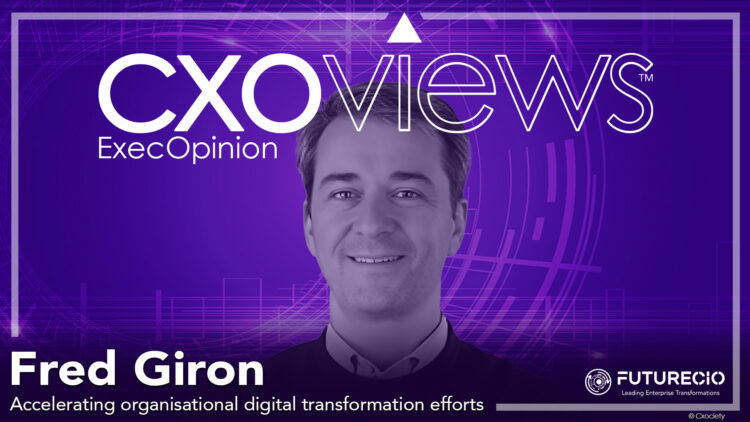In today's fast-paced digital era, businesses face a pressing reality: transform or risk being left behind in the competitive landscape.
A Harvard Business Review article cited that most large companies choose to transform, with 89% globally having begun a digital and AI transformation journey. However, most organisations achieve less than a third of their expected impact from recent digital investments.
As organisations work towards digital transformation, Fred Giron, VP and senior research director at Forrester discussed different organisational barriers that hinder it and effective ways to address them.

Top organisational barriers
For Giron, three primary factors hinder organisational digital transformation efforts: resource allocation, IT and business misalignment, and tech sprawl.
Alignment starts at the strategy definition.
Giron pointed out that budget constraints and talent shortages are the top challenges heading into 2025. However, these can be effectively addressed through close collaboration between IT teams and other departments, leading to streamlined resource distribution and enhanced strategic portfolio management.
According to the Forrester analyst, the misalignment between IT and business stakeholders can severely limit the success of IT investments and lead to fragmented and underutilised tech initiatives.
"Alignment starts at the strategy definition. Designing the IT strategy in a collaborative and immersive way can drive alignment and secure buy-in and cooperation as the strategic roadmap gets executed," he shared.
Finally, tech sprawl, a phenomenon characterised by the proliferation of technologies, applications, and platforms within an organisation, may increase complexity, costs, and cybersecurity risks. It can also lead to reduced efficiency.
Mitigating organisational barriers
CIOs can implement processes and frameworks to identify and mitigate organisational barriers hindering digital transformation efforts. Giron notes that Forrester's HPIT (High-Performance IT) framework provides a structured approach for CIOs.
The framework emphasises ensuring the IT strategy is closely aligned with the business objectives. This involves conducting regular strategic alignment workshops involving business and IT leaders to ensure that IT initiatives directly support business goals, implementing a governance framework that includes regular reviews and assessments to realign IT projects as business priorities evolve, and creating an Office of the CIO and a Strategic Value Office.
"These capabilities can drive alignment by bridging IT and business priorities, ensuring initiatives are strategically aligned, and resources are optimally allocated. This collaboration helps streamline decision-making, enabling faster execution and maximising value delivery across the organisation," he said.
Trust is also fundamental in mitigating organisational barriers to digital transformation. Giron recommends establishing transparent communication channels and reporting structures that provide visibility into IT operations and initiatives and using collaborative tools and platforms to encourage cross-functional teamwork between IT and business units, promoting a culture of trust and cooperation.
Additionally, Giron highlights implementing AI governance and trust frameworks: "This involves creating guardrails and policies for data access, usage, sharing, storage, and retention, as well as investing in security and privacy approaches like advanced encryption, data masking, differential privacy, and data clean room."
The analyst also underscored the importance of adaptivity: "develop and mature IT capabilities that can respond quickly to changing business needs."
Giron suggested that businesses optimise their operating models to achieve adaptivity and align team structures with strategic goals.
"This may involve building cocreating product teams or platform teams that can scale capabilities across the business, depending on specific needs," he explained.
Moreover, Giron finds it vital to implement agile methodologies to allow for flexible and iterative approaches to project management. He said investing in training and development programs encourages constant learning and improvement within the IT organisation.
Adopting best practices
Once organisations identify barriers, adopting proven best practices can help them navigate their transformation journey more effectively. Giron extracts best practices from research on organisational change management (OCM) for managing change and mitigating risks associated with digital transformation efforts.
Marketing specialist Tim Stobierski explained the OCM in an Harvard Business School Online article: "Virtually every organisation will, at some point, undergo a transition or change to remain viable and scale. Whether onboarding new employees, growing a department, or merging with another company, these changes can significantly impact your business trajectory. Unfortunately, organisational change isn't always easy to adapt to and can be intimidating for all team members impacted by it."
Giron listed seven steps to help the organisation progress with its digital transformation efforts. According to Giron, the first step is building the story for change: "Describe how the current change will benefit the business and customers, and be specific about where you will gain time savings, accuracy, growth, and profitability."
The Forrester analyst also highlighted the importance of identifying change leaders and proponents, bringing together all leadership roles involved in the change process to develop specific implementation plans, and investing in formal training.
Moreover, he underscored that organisations must encourage all lines of support, choose and implement a model that aligns with specific change, and combine change management with solid change leadership.
Trust, vision, and energy are essential for inspiring and guiding stakeholders through the transformation process.
"Trust, vision, and energy are essential for inspiring and guiding stakeholders through the transformation process," Giron said.
Gauging effectiveness
To effectively gauge IT and the overall organisation's performance, Forrester recommends considering a balanced scorecard approach that includes four dimensions: service, outcomes, agility, and health.
Giron explained that service-oriented metrics "focus on the reliability and quality of IT services, such as system uptime and incident resolution times. Tech execs must ensure the effectiveness of tech-based services for external customers, building on their traditional focus on internal customers."
Moreover, measuring outcomes helps evaluate the effectiveness of IT initiatives in contributing to strategic business goals, such as revenue growth, cost reduction, or customer experience improvements. Investments focus on funding business outcomes, not projects or requirement stacks.
Moreover, agility-focused metrics assess the speed and flexibility with which IT can respond to new opportunities or changes, such as the time to market for new features. Agility metrics help organisations remain competitive in rapidly changing environments.
Health metrics, such asmeasuring employee engagement, skills development, and resource utilisation, ensure the IT team's sustainable performance and ability to meet future challenges. These metrics are crucial for the long-term success and resilience of the IT function.
Digital transformation
In today's complex business landscape, embracing digital transformation is no longer optional. By identifying and addressing hindrances and employing strategies based on trust and collaboration, organisations can thrive in their digital transformation efforts.





